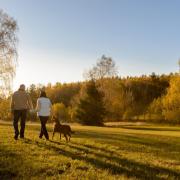As temperatures start to drop and nature’s pantry runs low, our garden birds need a helping hand to find food, water, and shelter this winter. Here’s our guide to help your feathered friends this festive period.

Ditch the diet
Food is harder to come by for birds in the winter. Insects are hibernating, grubs are buried deep in the ground, and snow and ice make it harder to forage. Birds need a lot of energy just to maintain their body temperature, but with shorter daylight hours to feed, it’s important we put out suitable high fat birdfood. Sunflower seeds, peanuts, or fat-based birdfood bars are great choices. If these fatty foods come in a mesh sacking, remove it from the netting and place the contents directly into a feeder or on a bird table – this will prevent birds from becoming trapped and injured in the mesh.
If your birdfeed supplies run low, your kitchen cupboards may hold the answer. Fruits like apples and pears, even when past their best, will be happily snapped up by blackbirds and thrushes. Grated mild cheese is a fantastic source of energy and protein, loved by robins, dunnocks, blackbirds and song thrushes. It will also help wrens if placed under hedgerows but remember not to feed blue or very strong cheeses.
Cooked pastry and defrosted peas are also great options, as well as cooked rice, pasta and the inside of potatoes.
Whilst high in energy, cooled fats and meat juices can cause serious harm to birds. If these types of fats get onto their feathers, they can affect their wings and feather waterproofing, so please stick to suet and lard.

Also, birds can’t digest salt and it will damage their nervous systems, so salty snacks like bacon rind or salted peanuts are a definite no.
Monitor how much food your garden birds eat and adjust the amount you put out accordingly – a build-up of uneaten food in or around an area can quickly turn rancid, so regularly discard any leftovers. During cold weather it’s a good idea to feed twice a day (if demand calls for it), once in the morning and again early afternoon.
The RSPB recommends that bird feeders, tables and baths are thoroughly cleaned every week. This helps reduce the spread of garden bird diseases. Wash using warm water and ideally a 5% disinfectant solution, then air dry outside. Don't bring your feeders into your house to clean – keep them outdoors, use separate utensils, and wear gloves. Always wash your hands when you've finished.
Birds quickly get used to a regular food supply, by feeding them now, you’ll encourage regular feathered visitors, just in time for the RSPB’s Big Garden Birdwatch Survey on January 26, 27 and 28. For your free Big Garden Birdwatch pack, text BIRD to 82727 or visit: rspb.org.uk/birdwatch.

Make a splash
Providing fresh water for your garden birds is also key to helping them thrive in your garden, they need it daily to drink and bathe. Use a birdbath, pond, or even a recycled, shallow container with a stone inside so that they can perch. During the winter garden water becomes vital as natural sources can freeze. Regularly check your bird baths during cold weather, in case a sudden frost makes them inaccessible for birds. If frozen, pour hot water over the surface to melt it. While hot water is fine for use in birdbaths it can shock pondlife, so to keep ponds ice free, float a light ball on the surface of your pond. It will be moved by the breeze and will keep a small amount of water ice-free!

Cornwall’s highlights
After taking care of your garden birds, wrap up and explore the wildlife at your local RSPB Cornwall nature reserve.
RSPB Hayle in West Cornwall is at its best during colder months, the weather makes the reserve a needed refuge for waders and waterbirds which breed further north in Greenland, Iceland, Scandinavia, eastern Europe, and Russia. Look out for large flocks of wigeon, grazing on the algae or in the rivers on Copperhouse Pool or Lelant Water; teal, around the main streams and riverbanks; lapwing, seen on Lelant Water and from the RSPB hide at Ryan’s Field; golden plover and thousands of gulls, including lesser black-backed gulls.

Also frequently seen during the winter months at RSPB Hayle are curlew, grey plover seen on Lelant Water and Ryan’s Field, redshank, greenshank, which like the muddy river channels, and kingfisher seen from the hide and around Hayle Harbour.
RSPB Marazion nature reserve is quieter during the winter, but there’s always a chance of seeing bittern. Sometimes flocks of starlings roost in the reedbed, so arrive an hour before sunset to get the best chance of watching them swirling and whirling overhead before they land. And Cornwall’s resident warbler, cetti’s warbler, can usually be heard all winter.




























